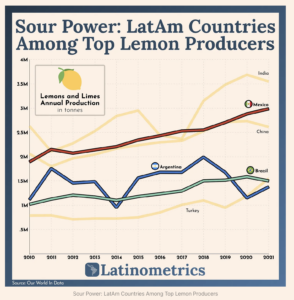July 6th, 2023
Courtesy of Latinometrics, an interesting look at the importance of Latin American and other emerging markets in global lemon production:
Let’s start this story about lemons and limes by clarifying some confusion: Generally speaking, lemons are ‘limas,’ and limes are ‘limones’ in Spanish. As native Spanish speakers, this has always been a significant source of frustration. It appears that somewhere in the evolution of language, someone messed up.
Both English words, lemon, and lime, are derived from the French word “limon,” a generic term for citrus fruit. If we examine the Spanish use of those words, it seems closer to its ancient Arabic origins. ‘Limón’ comes from the Arabic “l?m?n,” and lima comes from “l?ma.” In English, whoever started using the word lemon to describe the yellow variation of the citrus (?), in our estimation, wasn’t in touch with the word’s true origin.
The fruit’s harvesting itself dates back first to India — still the world’s largest producer — and then to the Middle East and Europe sometime in the second century AD, during the time of Ancient Rome. In southern Italy, you can visit the Cedar Museum in the beautiful region of Riviera dei Cedri.
Christopher Columbus himself brought the first lime seeds to the Americas in his second expedition, planting them in present-day Haiti and the Dominican Republic. Those seeds are the ancestors of what is now a massive industry.
Today, the Americas produces almost as much of the fruit as Asia (only about a 10% difference). Mexico has been leading the charge, making up 36% of the continent’s output, and since 1961 has grown its yearly yield by 24x, becoming the world’s second-largest producer.
Focusing primarily on The New Seven Sisters - the largely state owned petroleum companies from the emerging world that have become key players in the oil & gas industry as identified by Carola Hoyos, Chief Energy Correspondent for The Financial Times - but spanning other nascent opportunities around the globe that may hold potential in the years ahead, Wildcats & Black Sheep is a place for the adventurous to contemplate & evaluate the emerging markets of tomorrow.

